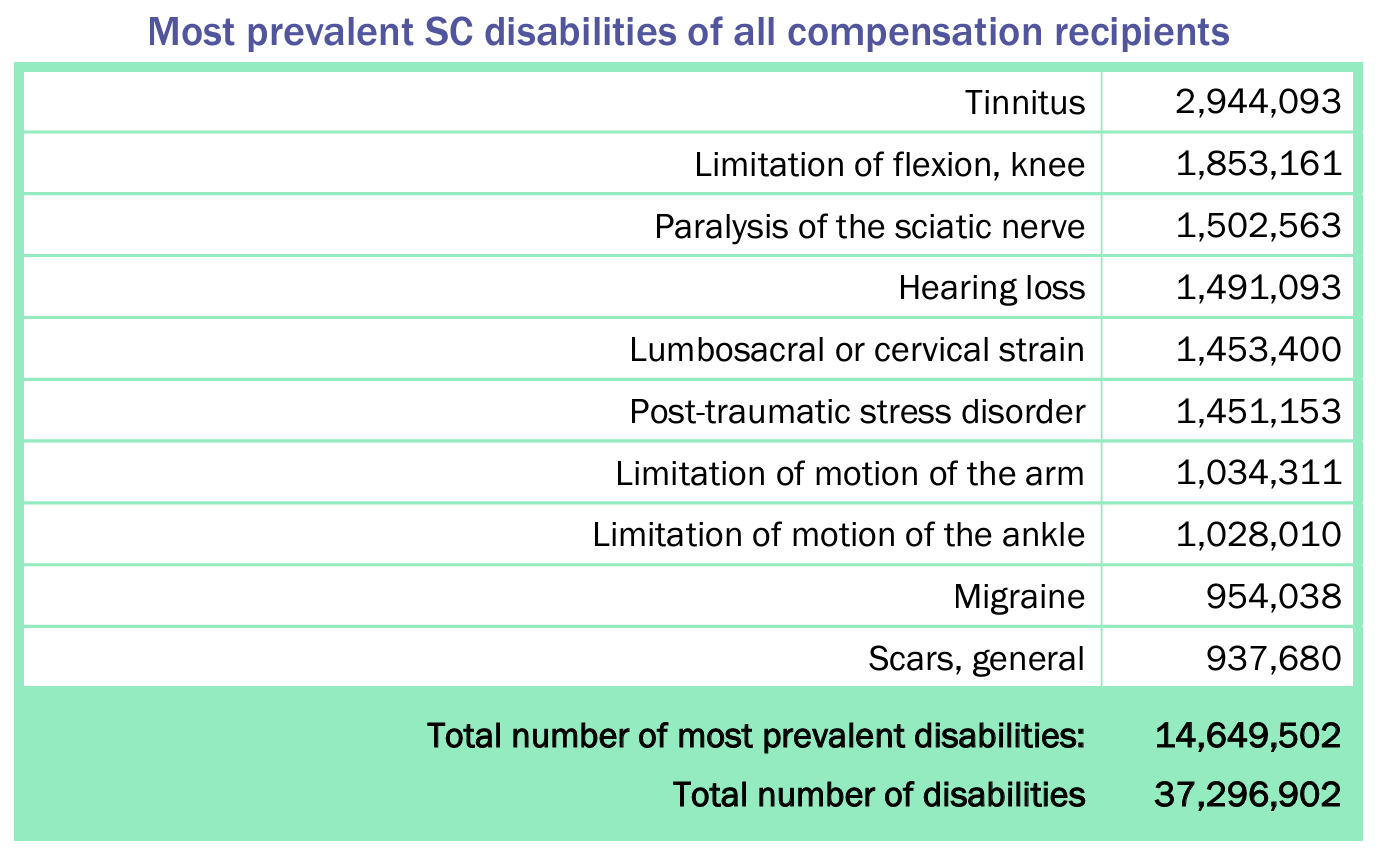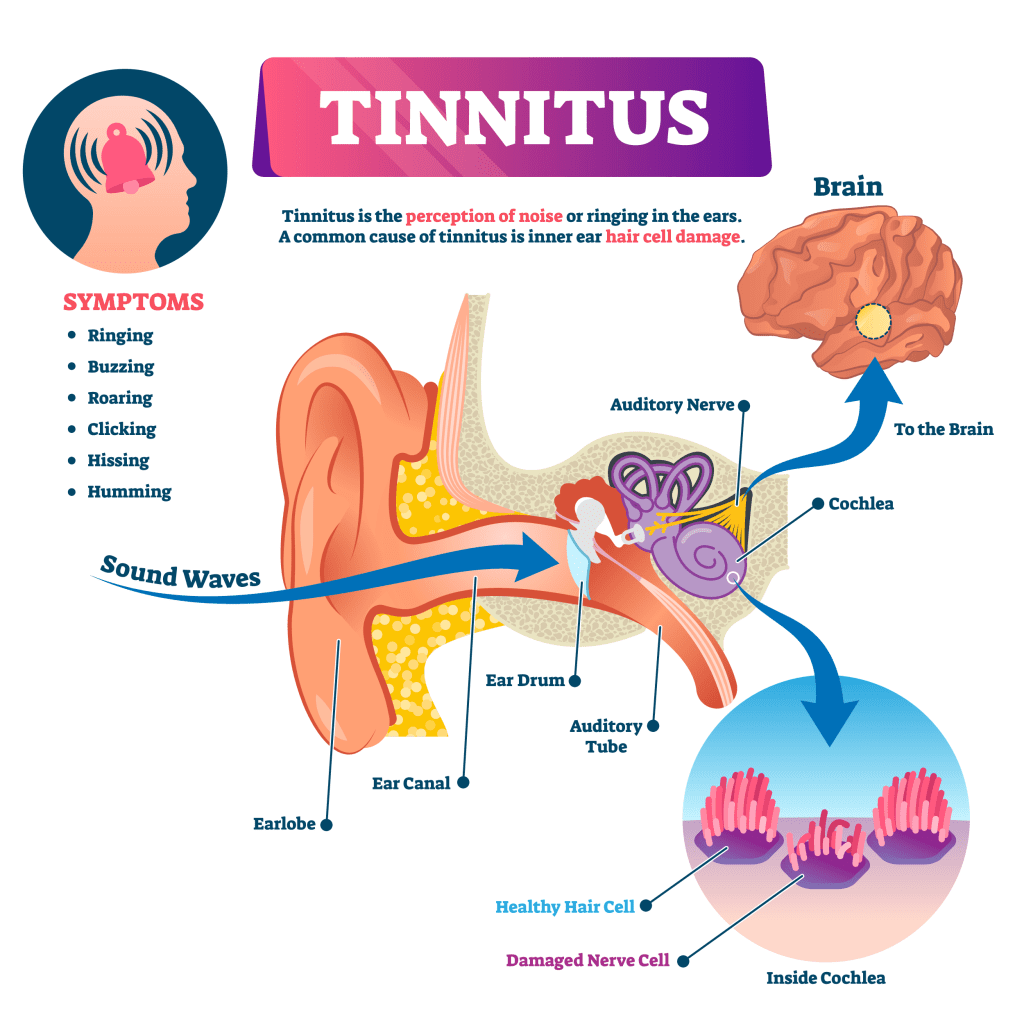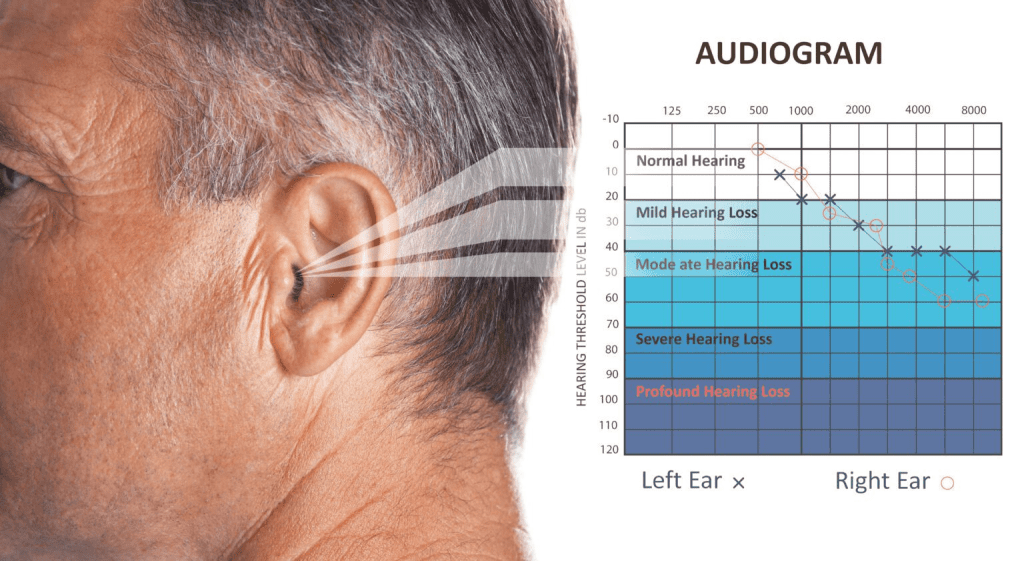Looking for Expert-Level VA Claim Answers?📱Call Us Now! 737-295-2226
Looking for the EASIEST VA Claims to WIN in 2025?
You’re in the right place!
We’ve just updated our list of the 10 easiest claims for VA disability to help you maximize the VA benefits you’ve earned for serving our country.
Of the 37,296,902 service-connected disabilities for all veteran demographics, this list of the easiest VA disability claims represents 14,649,502 of them or 39.3% of the total.
According to the latest VBA report to Congress, here are the Top 10 Easiest Things to Claim for VA Disability:

Table of Contents
Summary of Key Points
- Tinnitus is the #1 easiest VA disability to get service-connected in 2025.
- Easiest VA Claims: The easiest VA disability claims to win involve conditions that are straightforward to diagnose and document, including Tinnitus, Hearing Loss, Migraines, and PTSD.
- High Approval Rates: These 10 VA disabilities represent a significant portion (39.3%) of all service-connected disabilities, highlighting their commonality and ease of approval for benefits.
- Pro Tips for VA Disability Claims: Veterans should submit medical evidence, detailed personal statements, and nexus letters from private providers to strengthen their VA claims. Be sure to include a proper medical diagnosis, establish a “nexus” for service connection, and document the severity of symptoms to meet VA rating criteria.
List of the 10 Easiest Things to Claim for VA Disability
- #1. Tinnitus
- #2. Limitation of Flexion of the Knee
- #3. Paralysis of the Sciatic Nerve (Sciatica)
- #4. Hearing Loss
- #5. Lumbosacral or Cervical Strain
- #6. Post-Traumatic Stress Disorder (PTSD)
- #7. Limitation of Motion of the Arm
- #8. Limitation of Range of Motion of the Ankle
- #9. Migraines (Headaches)
- #10. Scars, General
What are the Easiest VA Disability Claims to Win Right Now?
#1. Tinnitus

Tinnitus, otherwise known as “Ringing-in-the-Ear-Syndrome” is the #1 easiest VA disability claim to win.
Tinnitus is when you experience ringing, hissing, buzzing, or other noises in one or both of your ears.
The ringing in your ears isn’t caused by an external sound, and other people usually can’t hear it, which is a condition called “Subjective Tinnitus.”
The VA rates Tinnitus under CFR Title 38, Part 4, Schedule for Rating Disabilities, Diagnostic Code (DC) 6260, Tinnitus, Recurrent.
The only VA Rating for Tinnitus is 10%.
There are no higher or lower ratings.
In total, 2,944,093 disabled veterans are service-connected for Tinnitus.
Pro Tip: There is no test for “Subjective” Tinnitus, which is the most common type of Tinnitus. Only you can hear Subjective Tinnitus, and you either have it or you don’t. Write a strong Statement in Support of a Claim for Tinnitus and explain the in-service event or injury that led to your ringing in the ear (e.g., worked on a flight line without property hearing protection).
Tinnitus VA Rating Changes: The VA might be changing the way it rates Tinnitus. Click HERE to read now.
#2. Limitation of Flexion, Knee

Limitation of Flexion of the Knee is the #2 easiest VA disability claim.
Knee pain is a common complaint that affects veterans of all ages.
Knee pain may be the result of an injury, such as a ruptured ligament or torn cartilage.
Other medical conditions, such as arthritis, gout, and infections can also cause knee pain.
The VA rates knee conditions under CFR Title 38, Part 4, Schedule for Rating Disabilities, DC 5257, Knee Impairment.
VA Ratings for Limitation of Flexion of the Knee range from 0 percent to 30 percent with interim breaks at 10 percent and 20 percent.
The highest schedular rating for limitation of flexion of the knee is 30%, which includes the following symptoms:
Recurrent subluxation or instability: Unrepaired or failed repair of complete ligament tear causing persistent instability, and a medical provider prescribes both an assistive device (e.g., cane(s), crutch(es), walker) and bracing for ambulation.
What are the VA disability ratings for Knee Pain?
If you have unfavorable ankylosis of the knee, it’s rated under DC 5256 instead, which has ratings of 30%, 40%, 50%, and 60% depending on the frequency, severity, and duration of symptoms to include limitation of range of motion:
- Extremely unfavorable knee ankylosis, with limitation of flexion at an angle of 45° or more is rated at 60%
- Unfavorable knee ankylosis with limitation of flexion between 20° and 45° is rated at 50%
- Knee ankylosis with limitation of flexion between 10° and 20° is rated at 40%
- Favorable angle in full extension, or in slight flexion between 0° and 10° is rated at 30%
1,853,161 disabled veterans suffer from service-connected knee pain.
Pro Tip: In accordance with the “Painful Motion” principle, if you have pain upon flexion or extension of your knee, the VA is required to award the minimum compensable rating for the condition, which is 10 percent.
#3. Paralysis of the Sciatic Nerve (Sciatica)

Sciatica (paralysis of the sciatic nerve) is the #3 easiest VA disability claim right now.
Sciatica refers to pain that radiates along the path of the sciatic nerve, which branches from your lower back through your hips and buttocks and down each leg.
Sciatica most commonly occurs when a herniated disk, bone spur on the spine, or narrowing of the spine (spinal stenosis) compresses part of the nerve.
This causes inflammation and pain to include some numbness in the affected leg.
The VA rates Sciatica under CFR Title 38, Part 4, Schedule for Rating Disabilities, DC 8520, Paralysis of the Sciatic Nerve.
VA Ratings for Sciatica fall between 10% and 80%, with breaks at 20%, 40%, and 60%.
The highest scheduler rating for Sciatica is 80%, which means you have complete paralysis of the sciatic nerve, your foot dangles and drops, and you have no active movement of the muscles below the knee.
What are the VA disability ratings for Sciatica?
- 80%: Complete paralysis; the foot dangles and drops, no active movement possible of muscles below the knee, flexion of knee weakened or lost
- 60%: Incomplete paralysis, severe with “marked muscular atrophy”
- 40%: Incomplete paralysis, moderately severe
- 20%: Incomplete paralysis, moderate
- 10%: Incomplete paralysis, mild with flexion of knee weakened or (very rarely) lost.
In total, 1,502,563 disabled veterans have a service-connected VA disability rating for Sciatica.
Pro Tip: A Limitation of Range of Motion (ROM) test with a goniometer should be performed at your C&P exam for Sciatica. Make the doctor stop as soon as you feel pain!
#4. Hearing Loss

Hearing Loss is the #4 easiest VA claim.
Hearing Loss is quite common in veterans and is defined by one of three types:
- Conductive (involves outer or middle ear)
- Sensorineural (involves inner ear)
- Mixed (combination of the two)
Aging and chronic exposure to loud noises (e.g., aircraft flight lines, gun ranges, heavy equipment) most contribute to Hearing Loss.
The VA rates Hearing Loss under CFR Title 38, Part 4, Schedule for Rating Disabilities, DC 6100, Hearing Loss.
VA Ratings for Hearing Loss range from 0 percent to 100 percent, with breaks at 10 percent, 20 percent, 30 percent, 40 percent, 50 percent, 60 percent, 70 percent, 80 percent, and 90 percent although the average VA rating for Hearing Loss is 10 percent, and many veterans have a 0 percent rating.
The highest scheduler rating for Hearing Loss is 100 percent, which means you have total deafness in both ears.
There are 1,491,093 disabled veterans service-connected for Hearing Loss.
Pro Tip: If you’ve been out of the military for more than 12 months, Hearing Loss is one of the most difficult claims to get service connected and rated above 0%. Get a Medical Nexus Letter to improve your odds of service-connected Hearing Loss.
#5. Lumbosacral or Cervical Strain

Lumbosacral or Cervical Strain is neck pain, and it’s the #5 easiest disability claim for VA benefits.
Neck pain is very common among veterans.
Neck muscles can be strained from poor posture, carrying heavy things, deployments, leaning over your computer, etc.
The VA rates Lumbosacral or Cervical Strain under CFR Title 38, Part 4, Schedule for Rating Disabilities, DC 5237.
VA Ratings for Neck Pain range from 10 percent to 100 percent, with breaks at 20 percent, 30 percent, 40 percent, and 50 percent.
The highest scheduler rating for neck pain is 100 percent, which means your entire spine is frozen in an unfavorable position.
A total of 1,453,400 disabled veterans are rated for neck conditions.
Pro Tip: In accordance with the “Painful Motion” principle, if you have pain upon flexion or extension of your neck, the VA is required to award the minimum compensable rating for the condition, which is 10 percent.
#6. Post-Traumatic Stress Disorder (PTSD)

PTSD is the #6 easiest thing to claim for VA disability and the most common service connected VA mental health condition.
PTSD is a mental health condition that’s triggered by experiencing or witnessing a terrifying event, which the VA calls a “stressor event.”
Common symptoms of PTSD include flashbacks, nightmares, severe anxiety, depression, or uncontrollable thoughts about the event.
The VA rates PTSD under CFR Title 38, Part 4, Schedule for Rating Disabilities, General Rating Formula for Mental Disorders, DC 9411, Post-Traumatic Stress Disorder.
VA Disability Ratings for PTSD range from 0 percent to 100 percent with breaks at 10 percent, 30 percent, 50 percent, and 70 percent.
The average VA rating for PTSD is 70%.
The highest scheduler rating for PTSD is 100 percent.
What is the PTSD VA rating scale?
100% VA Rating Criteria for PTSD: Total occupational and social impairment.
Symptoms include, but are not limited to:
- Gross impairment in thought processes or communication
- Persistent delusions or hallucinations
- Grossly inappropriate behavior
- Persistent danger of hurting self or others
- Intermittent inability to perform activities of daily living (including maintenance of minimal personal hygiene)
- Disorientation to time or place
- Memory loss for names of close relatives, own occupation, or own name
70%: Occupational and social impairment, with deficiencies in most areas, such as work, school, family relations, judgment, thinking, or mood.
Symptoms of the 70 percent VA rating for PTSD include but are not limited to:
- Suicidal ideation
- Obsessive rituals that interfere with routine activities
- Speech intermittently illogical, obscure, or irrelevant
- Near-continuous panic or depression affecting the ability to function independently, appropriately, and effectively
- Impaired impulse control (such as unprovoked irritability with periods of violence)
- Spatial disorientation
- Neglect of personal appearance and hygiene
- Difficulty in adapting to stressful circumstances (including work or a work-like setting)
- Inability to establish and maintain effective relationships
50%: Occupational and social impairment with reduced reliability and productivity.
Symptoms of the 50 percent VA rating for PTSD include but are not limited to:
- Flattened affect
- Circumstantial, circumlocutory, or stereotyped speech
- Panic attacks more than once a week
- Difficulty in understanding complex commands
- Impairment of short and long-term memory (e.g., retention of only highly learned material, forgetting to complete tasks)
- Impaired judgment
- Impaired abstract thinking
- Disturbances of motivation and mood
- Difficulty in establishing and maintaining effective work and social relationships
30%: Occupational and social impairment with occasional decrease in work efficiency and intermittent periods of inability to perform occupational tasks (although generally functioning satisfactorily, with routine behavior, self-care, and conversation normal).
The 30 percent rating for PTSD has symptoms that include but are not limited to:
- Depressed mood
- Anxiety
- Suspiciousness
- Panic attacks (weekly or less often)
- Chronic sleep impairment
- Mild memory loss (such as forgetting names, directions, recent events)
10%: Occupational and social impairment due to mild or transient symptoms which decrease work efficiency and ability to perform occupational tasks only during periods of significant stress, or symptoms controlled by continuous medication.
The 10 percent VA rating for PTSD has very mild symptoms that only flare up during periods of high stress.
0%: A mental condition has been formally diagnosed, but symptoms are not severe enough either to interfere with occupational and social functioning or to require continuous medication.
The 0 percent PTSD rating has no symptoms or continues medication keeps your symptoms in-check.
According to the VA’s published statistics, 1,451,153 disabled veterans have a service-connected VA disability rating for PTSD.
Pro Tip: PTSD claims always have a stressor event. If you’re wondering if your PTSD stressor is strong enough, here’s a quick litmus test: Did you fear for your life? If yes, your stressor is good enough to get a service-connected PTSD rating.
PTSD VA Rating Changes: The VA might be changing the way it rates PTSD. Click HERE to read now.
#7. Limitation of Motion of the Arm

Limitation of Motion of the Arm is the #7 easiest VA claim.
Frozen shoulder and arm are conditions characterized by stiffness and pain in your shoulder joint.
The VA rates arm conditions under CFR Title 38, Part 4, Schedule for Rating Disabilities, DC 5201, Arm, Limitation of Range of Motion.
VA Disability Ratings for the Arm range between 0% and 40%, with breaks at 10% and 20%.
What are the VA ratings for arm pain?
- The highest scheduler rating for a disability of the arm is 40 percent, which means your dominant arm has limitation flexion and/or abduction at 25° from the side; with the same symptoms of the non-dominant arm, rate at 30 percent.
- If your dominant arm has limited range of motion midway between the side and shoulder level (flexion and/or abduction limited to 45°), rate at 30 percent; for the non-dominant arm rate at 20 percent.
- If your arm is limited in range of motion at the shoulder level (flexion and/or abduction limited to 90°) rate at 20 percent for either the dominant or non-dominant side.
There are 1,034,311 disabled veterans rated for arm conditions.
Pro Tip: In accordance with the “Painful Motion” principle, if you have pain upon movement of your arm, the VA is required to award the minimum compensable rating for the condition, which is 10 percent.
#8. Limitation of Range of Motion of the Ankle

Limited Range of Motion of the Ankle is the #8 on our list of easy VA disability claims.
Your ankle is an intricate network of bones, ligaments, tendons, and muscles, which is strong enough bear your body weight and enable you to move.
This also means your ankle can be prone to injury and pain, especially due to your military service.
Most often, the VA rates ankle conditions under CFR Title 38, Part 4, Schedule for Rating Disabilities, DC 5271, Ankle, Limited Motion.
VA Disability Ratings for Ankle limitation of range of motion and pain fall between 10 percent and 20 percent.
The highest schedular rating for ankle pain is 20%.
What are the VA ratings for Ankle Pain?
- Marked limitation of range of motion of the ankle (less than 5 degrees dorsiflexion or less than 10 degrees plantar flexion) rate at 20%
- Moderate limitation of range of motion of the ankle (less than 15 degrees dorsiflexion or less than 30 degrees plantar flexion) rate at 10%
1,028,010 disabled veterans are service-connected and rated for ankle disabilities.
Pro Tip: In accordance with the “Painful Motion” principle, if you have pain upon flexion or extension of your ankle, the VA is required to award the minimum compensable rating for the condition, which is 10 percent.
#9. Migraines (Headaches)

Migraines (headaches) are an easy VA claim to win.
A migraine is a type of headache that can cause severe throbbing pain or a pulsing sensation, usually on one side of the head, but sometimes both.
It’s often accompanied by nausea, vomiting, and extreme sensitivity to light and sound.
Migraine attacks can last for hours to days, and the pain can be so severe that it interferes with your daily activities and might even cause you to have to lay down (prostrating migraine).
The VA rates Migraines (headaches) under CFR Title 38, Part 4, Schedule for Rating Disabilities, DC 8100, Migraines.
VA Ratings for Migraines range between 0 percent and 50 percent, with interim breaks at 10 percent, and 30 percent.
The maximum scheduler rating for Migraine headaches is 50 percent, which has symptoms such as: Very frequent and completely prostrating (you must lay down) with prolonged attacks productive of severe economic inadaptability (your headaches affect your work and ability to produce).
954,038 disabled veterans have a VA disability rating for migraines.
Pro Tip: The single most important word that can make or break your VA rating for migraines is the word “Prostrating.” The reason it’s so important is because the 30% and 50% VA ratings criteria contain the word “Prostrating” in reference to both frequency and severity of your headaches.
The best definition we could find for “Prostrating” comes from Dictionary.com: “To lay oneself flat on the ground face downward, especially in reverence or submission.” Prostrating is further defined as weakness, fatigue, distress, exhaustion, or illness. For example, “To reduce (someone) to extreme physical weakness.”
#10. Scars, General

Rounding out the 10 VA disability easy claims list are Scars, General at #10.
Scars form as part of your body’s natural healing process.
Your body builds tissue to repair damaged skin and close gaps due to an injury.
Scars come in all shapes and sizes.
They can result from accidents, burns, surgery, acne, and illness.
The VA rates Scars under CFR Title 38, Part 4, Schedule for Rating Disabilities, DC 7801, 7802, and 7805.
VA Ratings for Scars vary between 10 percent and 80 percent, with breaks at 20 percent, 30 percent, 40 percent, and 50 percent.
The highest scheduler rating for severe Scars is 80%.
If there is obvious significant tissue loss with severe distortion of three or more of the following: the eyes (and eyelids), ears, nose, mouth (and lips), chin, forehead, or cheeks, it is rated 80%. Two of the above is rated 50%. One of the above is rated 30%
However, the average VA rating for Scars is 10%.
According to VA statistics, 937,680 disabled veterans have a VA disability rating for scars.
Pro Tip: Ever heard the phrase “a picture is worth 1,000 words?” Using VA.gov, you should upload pictures of your Scars for the C&P examiner and VA Rater. It’s the #1 best way to prove you have Scars and how much of your body they cover.
Want Expert-Level Help with Your VA Claim? WE GOT YOUR SIX!
How does VA Claims Insider help veterans?
We make the confusing and frustrating VA claim process EASY through our 8-step proprietary system and one-on-one coaching; we’re the VA Claim EXPERTS you can trust, and YOU are never alone in this fight against the VA!
You’ll also receive VA disability expert Brian Reese’s SEM Method Blueprint—a proven formula that has helped over 25,000 veterans win their VA disability claims faster:
Strategy + Education + Medical Evidence = VA Rating and Compensation You Deserve FASTER!
Start today and unlock an exceptional level of service you deserve for serving our country:
➡️ You’ll hear from a VA Claim Expert over email within 15 minutes of signing up today.
➡️ You’ll hear from your Veteran Coach team within 24 hours of all inquiries during normal business days/hours.
➡️ Our terms are clear and simple: If we don’t win, you don’t pay. You have nothing to lose and everything to gain.
Click the red button below to start the process of winning your VA claim right now!
Veterans: Are You Ready to WIN, SERVICE-CONNECT, and INCREASE Your VA Rating FASTER? We Can Help!

- VA Claims Insider is the #1 most trusted name in VA disability claims.
- Work directly with a VA claims coach who can help lead you to VA claim victory.
- 25,000+ disabled veterans served in our membership programs since 2016.
- 30% average rating increase for veterans who complete our #1 rated Elite program.
- 4.7/5.0 average rating out of 5,500+ total reviews; over 4,500 5-star reviews.
About the Author

Brian Reese
Brian Reese is a world-renowned VA disability benefits expert and the #1 bestselling author of VA Claim Secrets and You Deserve It. Motivated by his own frustration with the VA claim process, Brian founded VA Claims Insider to help disabled veterans secure their VA disability compensation faster, regardless of their past struggles with the VA. Since 2013, he has positively impacted the lives of over 10 million military, veterans, and their families.
A former active-duty Air Force officer, Brian has extensive experience leading diverse teams in challenging international environments, including a combat tour in Afghanistan in 2011 supporting Operation ENDURING FREEDOM.
Brian is a Distinguished Graduate of Management from the United States Air Force Academy and earned his MBA from Oklahoma State University’s Spears School of Business, where he was a National Honor Scholar, ranking in the top 1% of his class.



